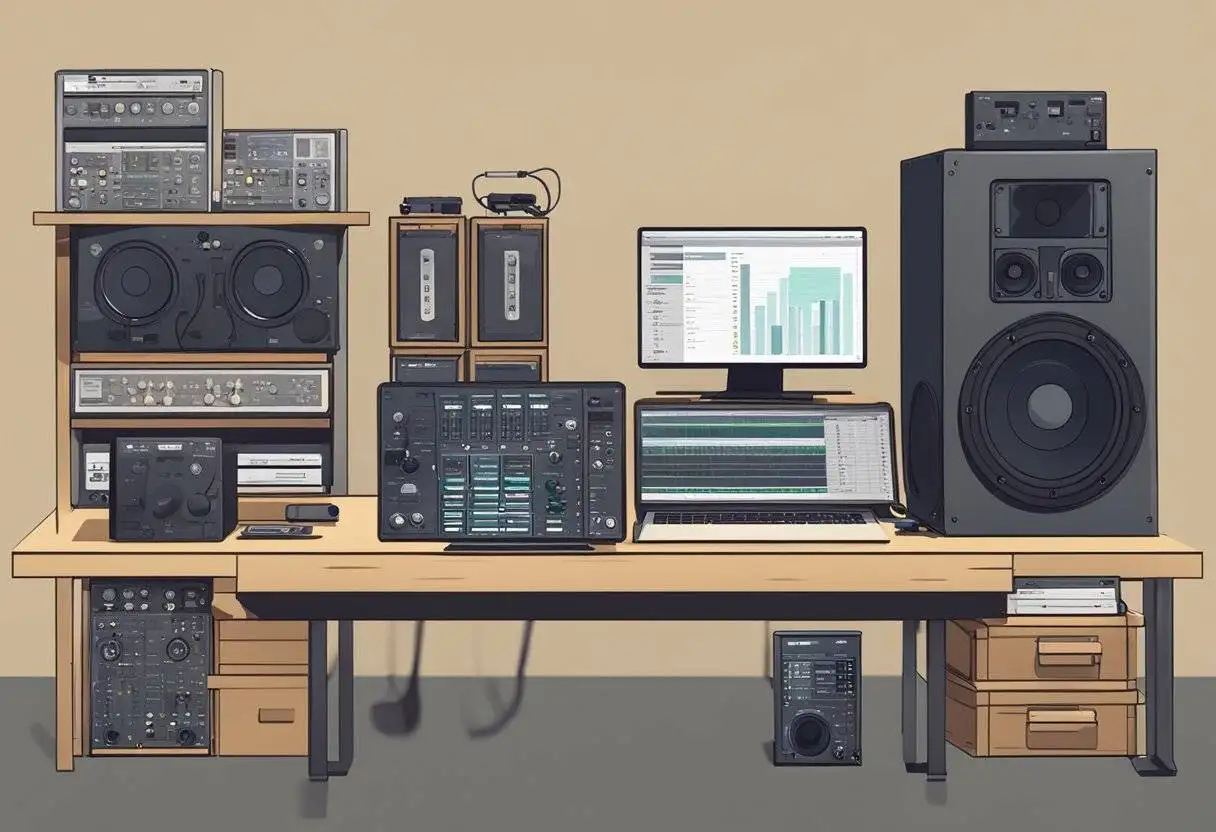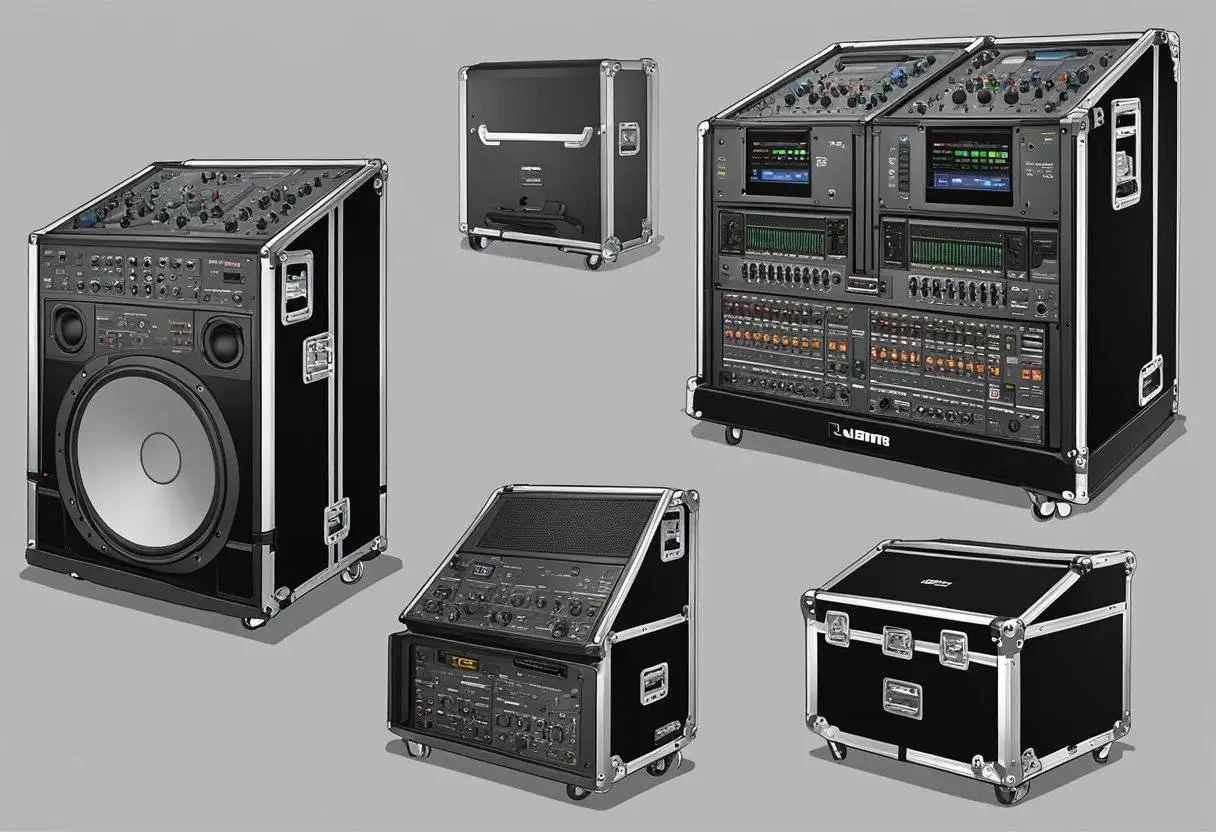When planning an event or performance as a DJ, ensuring that you have a reliable power source for your equipment is crucial. I am all too aware that a gig can’t proceed smoothly if I’m constantly worrying about whether my setup is receiving sufficient power. Determining the right size generator for DJ equipment involves understanding the overall power consumption of the gear and acquiring a generator that can handle that load with ease.

For most standard DJ setups, my experience indicates that a generator with a capacity of 2,000 to 2,800 watts usually suffices. This range typically covers the power requirements for speakers, a laptop and controller, and monitors. However, when I consider the need for uninterrupted power for a sustained period, I look for a generator that offers a little more than just the bare minimum wattage, ensuring that all my equipment runs without a hitch.
In providing music for events ranging from private parties to larger gatherings, I’ve found that generator sizes can vary depending on the scope of the event. A private party may only necessitate a 2,000 – 4,000-watt generator, but for larger setups or additional lighting and effects, I might need a generator with around 2400 watts preferred by industry standards. It’s important that I choose a generator based on not just the wattage but also on reliability and noise levels, as these factors can significantly influence the atmosphere of the event.
Understanding DJ Equipment Power Requirements
When planning a DJ setup, it’s crucial that I accurately determine the power requirements of my equipment. This ensures that the generator I choose can handle the load without causing power interruptions or equipment damage during a performance.
Assessing Total Input Power
The first step is to calculate total input power by tallying the wattage ratings of all the equipment I plan to use. This includes speakers, amplifiers, laptops, and controllers. Each piece of gear will have a power rating, usually listed in watts. I make a list of these values to understand my baseline power needs.
Estimating Power for Mixers, Amplifiers, and Speakers
Mixers typically consume less power than other components, but amps and speakers are the main power draws. For instance, a standard amplifier might require 500 watts, whereas active speakers might range from 250 to 1000 watts each, depending on their size and output capability. Passive speakers would also require a separate amp, which increases the total power needed. When selecting a generator, I must ensure it can handle the continuous power draw (often referred to as running watts) that these components demand.
Calculating Power for Lighting and Additional Accessories
In addition to audio equipment, I must account for lighting and other accessories. LED stage lights may consume around 10 to 100 watts per unit, but if I have moving head lights or strobes, the consumption could be significantly higher. Other accessories like fog machines or projectors can also add to the power load. I total the wattage of all these elements, adding a buffer to the generator’s capacity to account for power surges or additional unplanned gear.
Selecting the Right Generator for Your DJ Setup
When considering a generator for my DJ equipment, I focus on power requirements, portability, output quality, run time, and safety features. These are the pillars that ensure a successful performance without power interruptions or equipment damage.
Generator Size and Wattage Guide
To determine the correct size for my generator, I first add up the wattages of all my DJ equipment to calculate total power needs. It’s crucial to consider both starting and running watts since some devices draw more power upon startup. I generally look for at least 20-25% headroom above my calculated wattage to account for any unforeseen power surges and to ensure the longevity of my generator.
- For example:
- 2 turntables: 30W each
- Mixer: 10W
- Amplifier: 500W
- Speakers: 200W each
- Lights: 150W total
- Total without headroom: 1120W
- Recommended generator size with headroom: ~1400W
Portable vs. Inverter Generators
While a portable generator might be cost-effective, inverter generators like the Honda EU2200i are typically more suitable for my DJ setup due to their quieter operation and lighter weight, improving portability. Inverter generators provide clean power, essential for sensitive electronics like turntables and mixers, reducing the risk of damage from power fluctuations.
Considering Generator Output and Clean Power
The quality of the electrical output is critical for my DJ setup. Generators with THD (Total Harmonic Distortion) below 6% are ideal for delicate audio equipment. Models such as the Westinghouse WH2200iXLT and WEN 56475 provide this clean power, which protects my equipment from voltage spikes and drops.
Battery Charging and Runtime
A longer runtime means I can focus on my event without worrying about refueling. Generators like the Westinghouse WGen9500DF can run on duel fuel, using either gasoline or propane for flexibility and extended operation. I also ensure the generator has an efficient battery charging system to support any battery-powered gear I may have.
Essential Features for Safety and Efficiency
Safety cannot be compromised. I look for a generator with GFCI outlets, a muffler for noise reduction, and a comprehensive surge protector. The addition of a wheel kit can be a game-changer for moving the generator around. For example, models like the Champion Power Equipment 46539 often come with these features, offering both safety and convenience for my DJ events.
Financial Considerations When Purchasing a Generator

When selecting a generator, especially for DJ equipment, I consider the initial price, long-term maintenance costs, and fuel efficiency, all of which impact the overall investment and operational expenses.
Budgeting for Quality and Features
I am meticulous about allocating my budget to balance both quality and features. For DJ equipment, reliability is paramount, which often means investing in more reputable brands. For example, the Generac 7117 is known for its durability and user-friendly design. However, I also weigh additional features like portability and noise level, as they contribute to the generator’s functionality in various gig environments.
Analyzing Price vs. Performance
I scrutinize the price in relation to performance to ensure I get the best value. A higher-priced generator like the Westinghouse WGen9500DF can offer a dual fuel option, providing versatility with energy sources. This can be economically beneficial in the long run, as I have the flexibility to choose between gas and propane based on their current market prices. This choice can lead to savings if I judiciously monitor energy price fluctuations.
Cost of Maintenance and Fuel Efficiency
I track maintenance costs which include regular servicing and potential repairs. Generators that are easier to maintain, like the Champion Power Equipment 46539, save me money over time. Additionally, fuel efficiency greatly affects the ongoing cost. For instance, a single tank of gas should last according to the generator’s stated runtime. If the generator, such as a Generac generator, has a high fuel efficiency, I save money on fuel expenses for every event I perform. Compatibility with the DJ equipment is also critical – a mismatch can lead to inefficiencies and added costs.
Enhancing DJ Performance with Reliable Power Supply
As a DJ, providing a seamless audio experience is my top priority. Ensuring that the generator I choose offers steady, reliable power with minimal noise is critical to enhancing my performance, especially during crucial moments like a DJ gig or when producing music or videos where sound quality is paramount.

Noise Reduction Techniques for Outdoor and Indoor Events
I understand that noise can be a disrupting factor in both outdoor and indoor environments. For outdoor gear, I often turn to generators with noise reduction features to keep ambient sound levels low. When indoors, placing the generator as far away from the audio equipment as possible, using sound-absorbing materials around the generator, and utilizing a generator with quiet operation technology are practical steps to minimize disruption. For instance, using a generator with a decibel rating appropriate for the event can make a world of difference.
Maximizing Audio Equipment Potential
A generator with adequate wattage is vital to maximize the potential of audio equipment like JBL speakers. It’s not just about getting a generator; it’s about getting one that fits the power requirements of my equipment precisely. I always ensure that the generator can handle the combined wattage of all devices and provide additional headroom for power spikes. If the total wattage of my equipment is around 2400 watts, I’ll aim for a generator that can offer a bit more to ensure I’m not pushing it to its limits.
Avoiding Power Surges and Ensuring Continuous Power
To protect my equipment from power surges, I only use generators with automatic voltage regulation. This feature is essential to maintain a consistent voltage level, which is crucial for high-quality audio output and longevity of my indoor gear. Additionally, I prioritize generators that promise continuous power without interruptions, as maintaining a non-stop energy flow is critical to avoid malfunctions or shutdowns during a performance. An uninterrupted power supply guarantees that my sets remain dynamic and engaging from start to finish, reflecting my professionalism and reliability.
Frequently Asked Questions
In addressing the power needs for DJ equipment, it’s crucial to have precise knowledge about wattage, generator types, and calculating power requirements to ensure a flawless performance.
How many watts are typically required for a full DJ setup?
A full DJ setup generally requires a generator with around 2,000 to 2,800 watts. This range can comfortably handle the power load for standard equipment like speakers, a laptop, controllers, and monitors.
What are the power requirements for a live sound system, including DJ equipment?
The power requirements for a live sound system include not just the DJ equipment but also the amplifiers, mixers, and any additional lighting or effects. It is advised to opt for a generator that can provide a continuous output of around 2400 watts, ensuring all components can run without power constraints.
What capacity portable power station is recommended for outdoor DJ events?
Outdoor DJ events require a reliable power source. Selecting a portable power station with a capacity sufficient to manage peak loads is crucial. A generator between 2,000 to 3,000 watts should generally suffice for average outdoor DJ setups.
Which is preferred for DJ equipment: an inverter generator or a standard generator, and why?
For DJ equipment, an inverter generator is often preferred over a standard generator. It provides clean power with less risk of electrical fluctuation, which is important to protect sensitive audio equipment.
Are there specific generator features that are beneficial for powering DJ equipment during events?
Yes, generators featuring stable power output, low noise levels, and easy portability are significantly beneficial for DJ events. A power station with these features ensures minimal disruption and convenience during performances.
How do you calculate the necessary amperage for DJ equipment to determine the right generator size?
To calculate the necessary amperage for DJ equipment, sum up the amperage of each piece of equipment at peak load and aim for a generator amperage rating that exceeds this total by 25%. This accounts for headroom and ensures a margin of safety so the generator isn’t operating at full capacity constantly.
